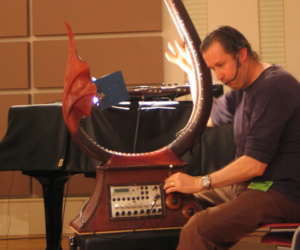Stu Favilla
Lecturer in Interaction Design, Swinburne University of Technology
Field of expertise: Spatial Sound, Interaction & Motion Design
In the time you have been working in your field, what impossible things have become possible?
I have been working in the fields of computer music, audio technology, music synthesis and interaction for more than three decades. During this time the theoretical notion of 360degree audio in the form of a soundfield has become a reality. Human spatial hearing has been modelled and approximated through headphone synthesis techniques. Motion capture sensors mounted on headphones allow us to effectively freeze the soundfield image and direct our virtual hearing to sound objects, voices and things recorded within the 360audio scene.
What impossible thing(s) are you working towards making possible, and why?
I am working towards improving the clarity of the spatial sound image and bringing spatial audio into other forms of computer interactions. Audio information other than speech or music can then be used to represent data or boost the saliency of visual displays.
What is an example of an impossible thing others in your field are currently working to make possible?
Others are using spatial sound to monitor the population of wildlife species in threatened habitats. A super interesting thing about sound is that it travels through a variety of media including other gasses, liquids and solids. Some scientists are using underwater soundfield microphones to listen to fish surveying their populations and gauging the health of river systems.
In your field are there any things that you predict will remain impossible, and why?
A super directional bass speaker may remain impossible. Currently we use ultrasound to do super directional audio. We use ultrasound waves to carry audio we can hear on a super high soundwave that we can’t hear. The technique allows us to beam sound like a laser. When the ultrasound beam hits an object like our ears, the reflections spill into lower frequencies and the carried sound (e.g. music or speech) is revealed. However, this technique cannot carry bass sounds.
In your opinion what formerly impossible and now possible thing in your field has made or is making the largest contribution to human or planetary flourishing?
Spatial sound technologies are helping people who are blind or visually impaired to navigate their environments. Spatial sound also being used to study noise (pollution) in crowded cities and amongst communities. Mapping and charting noise helps us understand its contribution to heart disease, depression and anxiety.
More information:
Learn more about how spacial sound is being used to study the environment and for creative outcomes at hearing places.
hearing places is an online umbrella for creative projects which unite sound and place. Founded by Australian sound artists Dr. Ros Bandt and Dr. Leah Barclay in 2012, hearing places now connects artists and researchers across Australia and beyond.

